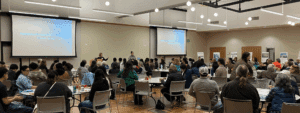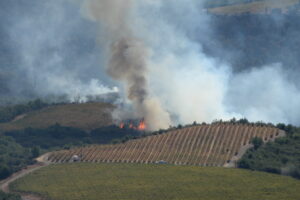How Development in the Wildland-Urban Interface Has Worsened California’s Insurance and Affordability Crisis
Devastating wildfires are a growing climate hazard throughout California and most of the Western US. The threats from this trend are more urgent as more people are living closer to the edges of forests and wildlands. Over 30% of California’s population now lives in the Wildland-Urban Interface (WUI), areas of land where houses (the built environment) meet and intermingle with wildland vegetation (the natural environment). CAL FIRE’s latest Fire Hazard Severity Zone Maps, released in March 2025, indicate that 5.1 million people—1 in 8 Californians—live in the two most dangerous fire zones.
As we’ve discussed in previous blogs, the WUI areas create a unique situation that fosters the start and spread of wildfires, often resulting in more ignitions and increased risks to lives and homes. More pressure for sprawl development in these areas threatens to put more lives and infrastructure in the path of wildfires.
The reasons for this increase are complex, and conventional wisdom suggests affordability as a key factor, as some developments in the WUI are among the most affordable in California. However, rapidly increasing long-term costs to homeowners in these areas are prompting us to reevaluate how affordable many of these areas really are.
To develop solutions that improve resilience to wildfires, we need first to understand the risk and impact on insurance and reinsurance, and how our land use decisions are impacting this trend. Let’s dive deeper:
Growing Risks, Increased Rates
As natural disasters become stronger and more frequent, almost every zip code in the U.S. has experienced a surge in insurance prices. Between 2020 and 2024, the average cost of home insurance in the United States increased by 20%, with an additional 8% increase expected by the end of 2025.
In California, we have seen this play out in extremes, with skyrocketing insurance prices, rising insurance nonrenewals, and a ballooning FAIR Plan—California’s insurance of last resort for those who cannot access private insurance. FAIR Plan policies are less comprehensive and less affordable than traditional insurance. In high-risk areas of the state, insurance premiums increased by as much as 42%, while one in five homes in these areas have lost insurance coverage since 2019.
Insurers are struggling to mitigate and diversify risk. One way insurers manage this risk is through the reinsurance market, which acts as insurance for insurance companies, allowing risk to be further diversified. This market, in turn, has also experienced a dramatic increase in price over the past few years. These costs are then passed on to homeowners, particularly those in high-risk areas where disasters are more likely to occur.
Insurance costs affect housing affordability in multiple ways. To obtain a mortgage, for example, homeowners are required to have insurance. As premiums increase, homeowners must pay or risk becoming delinquent on their mortgages. Fluctuating rates, increasing prices, and rising nonrenewals all complicate this process. Unfortunately, difficulty paying the mortgage is only the tip of the iceberg. Without access to insurance, buying, selling, or refinancing a home becomes next to impossible. When this process stagnates, property values drop as costs increase for homeowners.
Insurance in the WUI
Sprawling development into the WUI only exacerbates these compounding challenges. Frequently, the justification for this type of development focuses on affordability, arguably because these areas are less expensive than many parts of California. However, this framing increasingly overlooks critical long-term economic costs associated with WUI construction, especially the price and availability of insurance.
Homes in the WUI are uniquely vulnerable to wildfires and other disasters because of their proximity to undeveloped areas with high flammable materials, such as parched vegetation and overgrown forests. Despite the high risk associated with developing these areas, the WUI has been one of the fastest-growing land-use types in the United States.
When rising fire risk and soaring insurance prices are factored in, living in the WUI also becomes a risky venture: between 1985 and 2013, around 80% of homes destroyed in wildfires were located in the WUI.
As this risk area expands, insurance companies will either leave the state or take on increasingly large exposures. Neither option is good. When an insurer leaves the state, often the only option for homeowners is the California FAIR Plan. As of June 2025, the number of FAIR Plan policies had risen to 610,179, an increase of 154% since 2021.
These policies are expensive, and often cover less than standard home insurance. And, when the FAIR Plan runs out of money, 50% of its assessment to recoup the funds can be passed on to policyholders statewide, equating to hundreds of millions of dollars. As the FAIR Plan is stretched thin, homeowners across the state are paying the price.
Similarly, when insurers stay in high-risk areas, their ability to pay for catastrophic losses is strained. To account for and mitigate this increased exposure, insurance premiums go up. Moreover, like with the FAIR Plan, large losses can be passed on to policyholders across the state in the form of rate hikes.
For example, after citing extreme financial distress due to an expected $7 billion in claims from the L.A. fires, State Farm has been permitted to raise rates an average of 17% for homeowners. The ability to spread the cost of these and FAIR Plan losses throughout the state means that the financial burden of building in the WUI is not shouldered just by those who live there, but also by policyholders statewide, showing that the consequences of the sprawl to urban fringes goes beyond the local level: the financial impacts of increased premiums are felt not only by those who live in high-risk areas, but in communities across the state.
Impacts on vulnerable communities
The impacts of rising insurance rates will disproportionately impact vulnerable communities, especially low-income homeowners. Increasing insurance premiums require low-income families to make financial trade-offs, causing many to fall behind on mortgage payments. Homeowners who have a mortgage backed by the Federal Housing Administration (FHA) tend to be first-time buyers with lower incomes, putting them at risk of these circumstances. These families tend to be close to their affordability limit even before the increase occurs; for example, around 80% of first-time homeowners with an FHA loan have less than one month’s savings to cover a mortgage payment should they become unemployed or face a medical emergency. Moreover, those on fixed incomes, such as older Americans, will face difficulties with increasing premium prices.
However, it’s not just homeowners who are impacted by rising insurance premiums, but also renters. As insurance prices hike, landlords raise rent to cover costs. Around 44% of Californians are renters, and 30% of the state’s renters are deemed severely cost-burdened (meaning at least half of their income is spent on housing). With many already struggling to pay rent, increases due to rising insurance premiums could severely impact the market. No part of the real estate market is safe from the impacts of rising insurance.
This also takes a toll on affordable housing developments. In California, an analysis of 130 affordable housing developments across the state found that median annual per-unit insurance expenses rose 142% between 2019 and 2024, with some properties seeing increases of up to 500%. Unlike standard housing, most affordable housing developments cannot pass on the cost of these prices through rent increases. This feature helps to keep these developments affordable, but it creates challenges for providers. In a 2023 national survey, more than 50% of affordable housing providers indicated that they would need to decrease or postpone investments in existing and new housing projects due to rising insurance costs.
What’s Next?
As recent extreme fires showed, this crisis is reaching a boiling point if we don’t change course quickly, especially when it comes to where we house our residents.
As California and other Western US communities seek to improve housing affordability by increasing supply, it’s important to prioritize climate-smart infill development within already urbanized areas, near amenities and opportunities, and away from climate hazards. This diverts development from ecologically sensitive and fire-prone areas while also promoting walkable, transit-friendly cities, as well as reducing the ongoing insurance costs associated with homeownership. Analyzing these long-term costs as part of land use planning is critical to inform decisions that truly lead to a more affordable and resilient future.
Header photo credit: Fire in the Hills by CALfire Flickr/CC-BY-NC
*Contributing authors: Sadie Wilson, Daniela Ades
Copyediting: Daniela Ades
Revision: Amanda Brown-Stevens, Jessie Rountree





